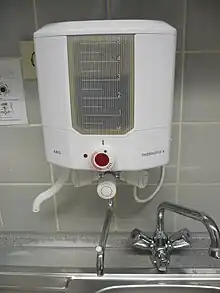

An electric water boiler, also called a thermo pot, is a consumer electronics small appliance used for boiling water[1][2] and maintaining it at a constant temperature in an enclosed reservoir. It is typically used to provide an immediate source of hot water for making tea,[1] hot chocolate, coffee,[1] instant noodles, or baby formula, or for any other household use where clean hot water is required. They are a common component of Japanese kitchens and the kitchens of many East Asian countries but are found in varying use globally. Smaller units are portable. Some thermo pots are designed with a feature that can purify water.[3]
Components
An electric water boiler consists of a water reservoir with a heating element at the bottom. Some models offer multiple temperature settings. Other models are part of larger water systems that boil water and provide hot, cold, and lukewarm water. Water may be dispensed in various ways, e.g. by pouring, an electric pump or by pressing a large button that functions as a diaphragm pump. Electric water boilers have a built in thermostat that detects when water has reached its boiling point of 100 °C (212 °F) to automatically shut off.
Sedimentation
Sedimentation is the accumulation within the water reservoir of natural minerals that exist in trace amounts in municipal water mains, mainly calcium carbonate. Heating the water causes the minerals to separate and fall to the bottom of the reservoir. This buildup can eventually create a variety of noises in gas boilers, reduce the efficiency of the unit and give rise to a sulfur (or rotten-egg) smell. Vinegar or citric acid can be used to descale electric kettles.[4]
Uses
Some electric water boiler models enable tea to be steeped at a desired, adjustable temperature.[5]
See also
References
- 1 2 3 Max Cryer (8 October 2010). The Godzone Dictionary: Of Favourite New Zealand Words and Phrases. ReadHowYouWant.com. p. 64. ISBN 978-1-4587-7952-6. Retrieved 2014-03-25.
- ↑ Leon Reznik (21 August 1997). Fuzzy Controllers Handbook: How to Design Them, How They Work. Newnes. p. 10. ISBN 978-0-08-050716-3. Retrieved 2014-03-25.
- ↑ Matsushita Electric Corporation of America (1992). Annual report.
- ↑ Christopher Goodall (4 May 2012). How to Live a Low-Carbon Life: The Individual's Guide to Stopping Climate Change. Routledge. p. 157. ISBN 978-1-136-56406-2. Retrieved 2014-03-25.
- ↑ "The Tide in Tea - Features - Gourmet Retailer Magazine".
As tea drinkers become increasingly sophisticated, so too do the equipment and brewing techniques for this aromatic beverage. A number of companies [offer] precision temperature control
Further reading
- Materials and the Environment: Eco-informed Material Choice - M. F. Ashby. pp. 198–199. Retrieved on 2014-03-25.